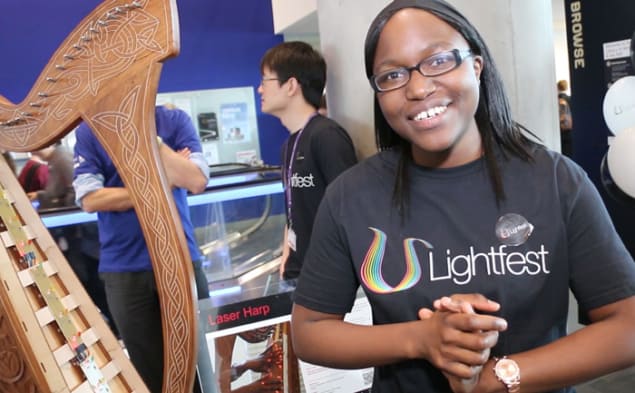
The International Year of Light and Light-based Technologies (IYL 2015) will soon draw to a close, in a year that has seen thousands of events celebrating the science and applications of light in more than a 100 countries worldwide. Officially launched in January at the headquarters of the UN Educational, Scientific and Cultural Organization (UNESCO) in Paris, IYL 2015 has involved more than 100 partners from 85 countries – including the Institute of Physics, which publishes Physics World.
“IYL 2015 is among the most successful and visible of any of UNESCO’s international observances,” says John Dudley, president of the European Physical Society (EPS), which came up with the idea for the year of light in 2009. “This year has seen unparalleled co-operation between partners who have not traditionally worked together.”
A range of international and national events have been held, touching on light in everything from archaeology and communications to medicine and the arts. The Light: Beyond the Bulb project, for example, has put the science of light into public settings around the world, such as parks, metro-stations, airports and libraries, while the Study after Sunset initiative promoted the use of solar-powered light-emitting-diode (LED) lanterns in parts of the world where there is little or no reliable source of light after dark. The iSPEX-EU campaign has used “citizen science” to measure air pollution with smartphones; while children, teachers, scientists and artists from more than 25 countries came together to write the “SkyLight” science opera.
Leaving a legacy
Organizers behind the year hope that the impact of IYL 2015 will be felt for many years to come. Dudley says that a number of projects are already under way to put long-term programmes into place. The international firm Royal Philips Lighting, for example, has already called on governments to work together and end light poverty by 2030.
“In developing countries, the need for reliable and safe lighting for education and improved quality of life is now clear at both the public and political level,” says Dudley. “Another example is the awareness of how smart lighting and good design can reduce energy waste and cut light pollution – it is hoped that standards associations will now follow this up to influence building codes.”
Dudley says that IYL 2015 has also allowed the scientific community to make governments and funding agencies aware of the “many ways in which photonics and associated technologies impact their lives, in areas from medicine to communications”. One important message, he adds, is that many of the applications we benefit from today have their origins in basic curiosity-driven research carried out decades ago. “It is not easy to change the mindset of short-term budgets,” he says. “But if we have succeeded even a little, this will be among the most important legacies of the year.”
The closing ceremony for IYL 2015 will take place on 4–6 February in Mérida, Mexico, and is set to be attended by senior figures behind the year, including Nobel laureates, diplomats and business leaders, with a scientific programme consisting of plenary lectures, panel sessions and parallel workshops. It will review the year and its successes, and will focus in particular on ensuring an enduring legacy. A series of light-themed films created by Physics World over the last year will be shown in Mérida as part of a film festival.
“The ceremony aims to identify new projects and products that can have a positive impact on people’s lives and the environment,” says Ana María Cetto of the National Autonomous University of Mexico. “It will address major issues such as light in medicine, the build environment, culture and the arts, as well as the use of light in research, education, energy and industry. We will also look at how to create a dark-sky-friendly future.”
Raising awareness
The UN has declared “international years” since 1959, to draw attention to topics deemed to be of worldwide importance. In recent years, there have been a number of successful science-based themes, including physics (2005), astronomy (2009), chemistry (2011) and crystallography (2014).
This year was picked to celebrate light because it marks a number of anniversaries, including 1000 years since the publication of the work on optics by Ibn al-Haytham, during the Islamic Golden Age. The year also marks 200 years since Augustin-Jean Fresnel’s seminal paper introducing the notion of the wave nature of light, 150 years since James Clerk Maxwell’s work on electromagnetism that paved the way for technologies from lasers to mobile phones, as well as the centenary of the incorporation of the speed of light as an essential part of our description of space and time in Einstein’s equations of general relativity.
A resolution endorsing IYL 2015 was first adopted by UNESCO in October 2012 and submitted to the UN in November 2013. At the 68th session of the UN General Assembly in Paris in September 2013, the resolution was then adopted to declare 2015 the International Year of Light and Light-Based Technologies, to “raise awareness of how optical technologies promote sustainable development and provide solutions to worldwide challenges in energy, education, agriculture, communications and health”.
- A free-to-read digital edition containing 10 of our very best feature articles on the science and applications of light is available either by downloading the Physics World app onto your tablet or smartphone, which is available for iOS and Android from the App Store and Google Play, or on your desktop
- For a selection of the best Physics World videos on light, including a series of specially commissioned videos for IYL 2015, visit Physics World Showcase: Light



